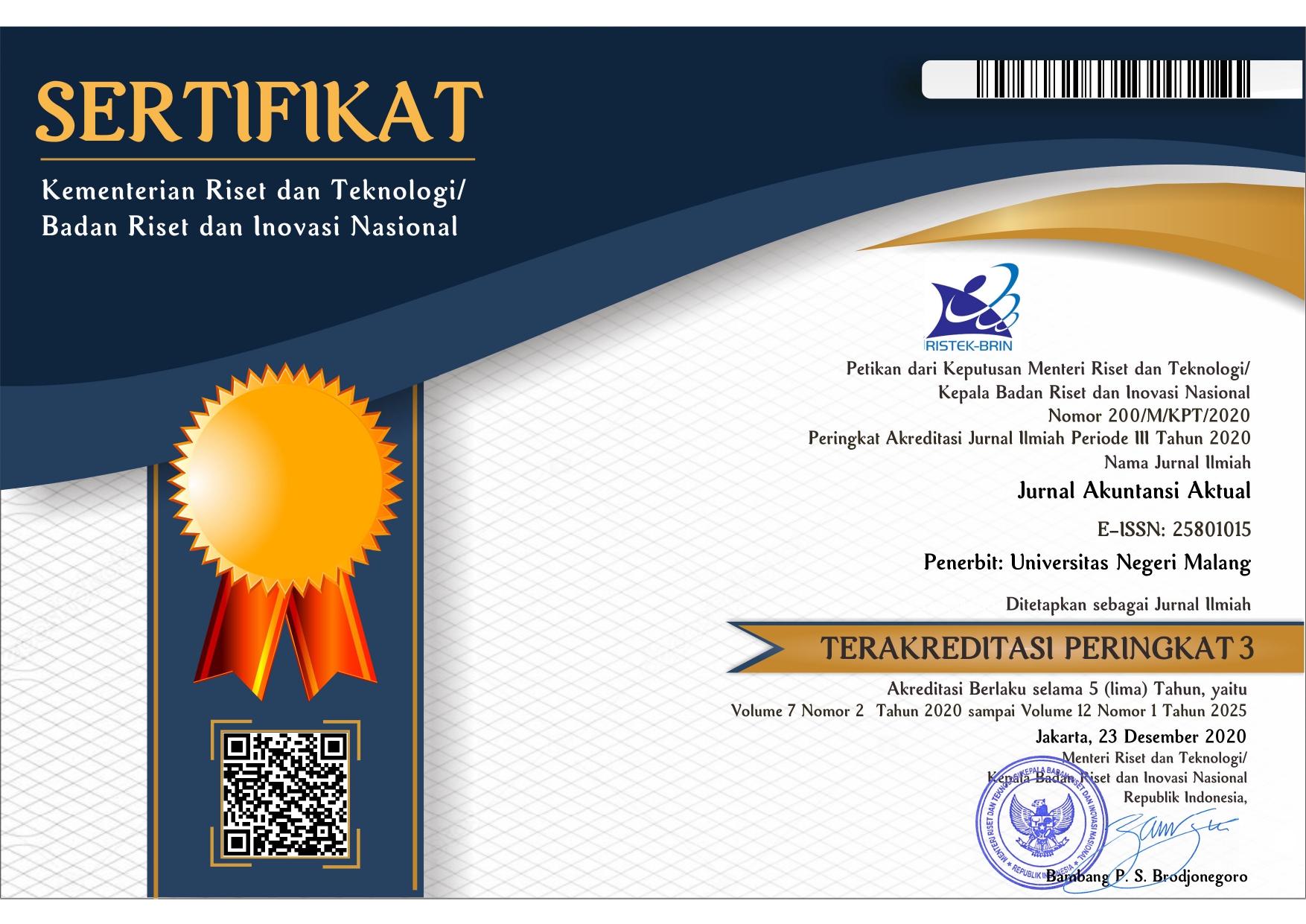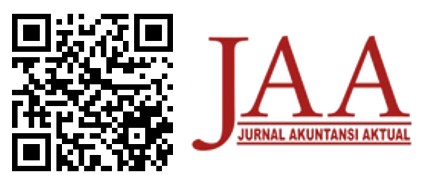Theory of Planned Behavior as an Antecedent in Predicting Fraudulent Intentions of Academic Accountants and Non-Academic Accountants
Abstract
Purpose:
Individual behavior is a representation of what is believed. Likewise, an accountant intends to commit financial statement fraud. Related to predicting individual behavior to do or not to do something action can use the Theory of planned behavior (TPB). This research examines three main variables in TPB, attitude, subjective norms, and perceived behavioural control on academic and non-academic accountants' fraud intentions through the Theory of Planned Behavior (TPB) variables.
Method:
This research is quantitative, with primary data obtained from questionnaires sourced from respondents. Respondents were academic and non-academic accountants. The research sample was selected using a purposive sampling method with specific criteria. The partial least squares (PLS) method was used to analyze the data.
Findings:
The findings suggest that attitudes and subjective norms significantly positively affect the intention to commit financial statements fraud in academic and non-academic accountants, while perceived behavioural control does not significantly affect the intention to commit fraud in financial reporting.
Originality/Value :
Research that examines the intentions of academic accountants and non-academic accountants in committing financial statement fraud and studied using the theory of planned behavior is the first to be conducted.
Keywords
Full Text:
PDFReferences
Ajzen, I. (1991). The Theory of Planned Behavior. Organizational Behavior and Human Decision Processes, 50(2), 179-211. doi:10.1016/0749-5978(91)90020-T.
Ajzen, I. & Fishbein, M. (1977). Attitude-Behavior Relations: A Theoretical Analysis and Review of Empirical Research. Psychological Bulletin, 84(5), 888–918. doi:10.1037/0033-2909.84.5.888.
Aris, N. A., Arif, S. M. M., Othman, R., & Zain, M. M. (2015). Fraudulent Financial Statement Detection Using Statistical Techniques: The Case of Small Medium Automotive Enterprise. The Journal of Applied Business Research, 31(4), 1469 1478. doi:10.19030/jabr.v31i4.9330.
Awang, Y. (2019). The Influences of Attitude, Subjective Norm and Adherence to Islamic Professional Ethics on Fraud Intention in Financial Reporting. Journal of Islamic Accounting and Business Research, 10(5), 710–725. doi:10.1108/JIABR 07 2016-0085.
Awang, Y. & Ismail, S. (2018). Determinants of Financial Reporting Fraud Intention among Accounting Practitioners in the Banking Sector: Malaysian Evidence. International Journal of Ethics and Systems, 34(1), 32–54. doi:10.1108/IJOES 05 2017-0080.
Brown, J. O., Hays, J., & Stuebs, M. T. (2016). Modeling Accountant Whistleblowing Intentions: Applying the Theory of Planned Behavior and the Fraud Triangle. Accounting and the Public Interest, 16(1), 28–56. doi:10.2308/apin-51675.
Carpenter, T. D. & Reimers, J. L. (2005). Unethical and Fraudulent Financial Reporting: Applying the Theory of Planned Behavior. Journal of Business Ethics, 60(2), 115 129. doi:10.1007/s10551-004-7370-9.
Carter, D. J. (2022). Fraud Education in the Undergraduate Accounting Curriculum: A Qualitative Study (Doctoral Dissertation, Nortcentral University). Https://www.proquest.com/openview/482fc757dd999bba5fe8be2d38464e41/1.pdf?pq-origsite=gscholar&cbl=18750&diss=y.
Chen, D., Wang, F., & Xing, C. (2021). Financial Reporting Fraud and CEO Pay Performance Incentives. Journal of Management Science and Engineering, 6(2), 197–210. doi:10.1016/j.jmse.2020.07.001.
Hair, J. F., Hult, G. T. M., Ringle, C. M., Sarstedt, M., Danks, N. P., & Ray, S. (2021). Partial Least Squares Structural Equation Modeling (PLS SEM) Using R. New York: Springer International Publishing. doi:10.1007/978-3-030-80519-7.
Latan, H., Ringle, C. M., & Jabbour, C. J. C. (2018). Whistleblowing Intentions among Public Accountants in Indonesia: Testing for the Moderation Effects. Journal of Business Ethics, 152(2), 573–588. doi:10.1007/s10551-016-3318-0.
Li, R. (2015). Detection of Financial Reporting Fraud Based on Clustering Algorithm of Automatic Gained Parameter K Value. International Journal of Database Theory and Application, 8(1), 157–168. doi:10.14257/ijdta.2015.8.1.17.
Mustafida, N. & Mursita, L. Y. (2022). Pemodelan Intensi Whistleblowing Pegawai di Indonesia: Aplikasi Whistleblowing Triangle. Integritas: Jurnal Antikorupsi, 7(2), 233–244. doi:10.32697/integritas.v7i2.265.
Nuswantara, D. A. & Maulidi, A. (2021). Psychological Factors: Self- and Circumstances caused Fraud Triggers. Journal of Financial Crime, 28(1), 228–243. doi:10.1108/JFC-05-2020-0086.
Owusu, G. M. Y., Bekoe, R. A., Anokye, F. K., & Okoe, F. O. (2020). Whistleblowing Intentions of Accounting Students: An Application of the Theory of Planned Behaviour. Journal of Financial Crime, 27(2), 477–492. doi:10.1108/JFC 01 2019 0007.
Park, H. & Blenkisopp, J. (2007). Whistleblowing as Planned Behaviour – A Survey of South Korean Police Officers. Journal of Business Ethics, 85, 545–556. doi: 10.1007/s10551-008-9788-y.
Respati, N. W. T. (2011). Pengaruh Locus of Control terhadap Hubungan Sikap Manajer, Norma-Norma Subyektif, Kendali Perilaku Persepsian, dan Intensi Manajer dalam Melakukan Kecurangan Penyajian Laporan Keuangan. Jurnal Akuntansi dan Keuangan Indonesia, 8(2), 123–140. doi:10.21002/jaki.2011.08.
Reurink, A. (2018). Financial Fraud: A Literature Review. Journal of Economic Surveys, 32(5), 1292–1325. doi:10.1111/joes.12294.
Safrida, Simbolon, R., Riana, Z., & Pratama, I. (2023). Preventive, Education, and Repressive Strategies on the Performance of Indonesian Government Civil Servants, with Antifraud Supervision as an Intervention. Journal of Modern Project Management, 11(1), 220–235. doi:10.19255/JMPM03115.
Sarikhani, M. & Ebrahimi, F. (2021). Whistleblowing by Accountants: An Integration of the Fraud Pentagon and the Extended Theory of Planned Behavior. Meditari Accountancy Research, 30(6), 1740-1763. doi:10.1108/MEDAR-10-2020-1047.
Shimp, T. A. & Kavas, A. (1984). The Theory of Reasoned Action Applied to Coupon Usage. Journal of Consumer Research, 11(3), 795-809. doi:10.1086/209015.
Utami, I., Wijono, S., Noviyanti, S., & Mohamed, N. (2019). Fraud Diamond, Machiavellianism and Fraud Intention. International Journal of Ethics and Systems, 35(4), 531–544. doi:10.1108/IJOES-02-2019-0042.
Wuryaningsih & Dzulhasni, S. (2022). Intensi Whistleblowing Mahasiswa dan Profesional Akuntansi: Aplikasi Theory Planned of Behavior. Jurnal Akuntansi, 32(8), 2167 2179. doi:10.24843/EJA.2022.v32.i08.p16.
Yuniarwati, Y., Ardana, I. C., & Dewi, S. P. (2022). Theory of Planned Behavior for Predicting Fraudulent Financial Reporting Intentions. Proceedings of the 3rd Tarumanagara International Conference on the Applications of Social Sciences and Humanities (TICASH 2021), 655, 529–537. doi:10.2991/assehr.k.220404.083.
Zakaria, M., Azmawaty, S. N., Razak, A., & Noor, W. N. B. W. M. (2016). Effect of Planned Behaviour on Whistle Blowing Intention : Evidence from Malaysian Police Department. Middle-East Journal of Scientific Research, 24(7), 2352–2365. doi:10.5829/idosi.mejsr.2016.24.07.22667.
DOI: http://dx.doi.org/10.17977/um004v11i12024p073
Refbacks
- There are currently no refbacks.

This work is licensed under a Creative Commons Attribution-ShareAlike 4.0 International License.
Jurnal Akuntansi Aktual is indexed by:















